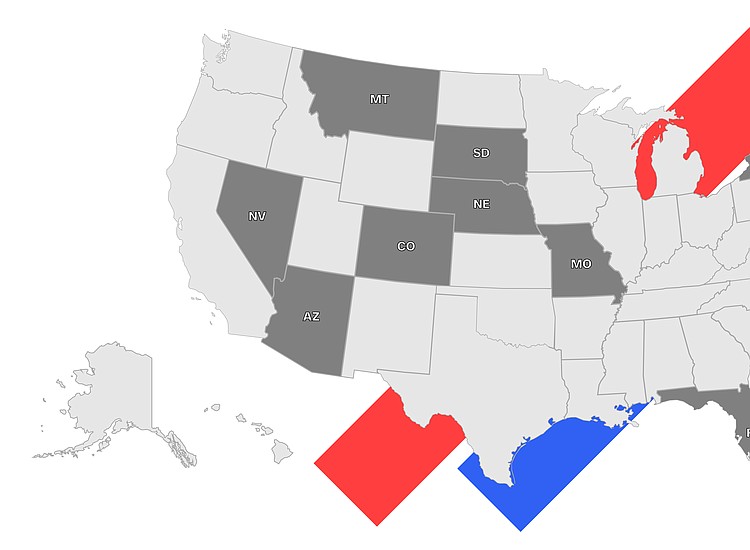
In the wake of the U.S. Supreme Court’s 2022 decision to overturn Roe v. Wade, voters across 10 states have weighed in on measures related to abortion rights. This election saw a mixture of victories for those advocating for abortion protections and setbacks for efforts to expand access in more conservative regions.
Seven states passed measures either protecting or expanding abortion access, while efforts to enshrine reproductive rights failed in several others, highlighting the deep divisions on this issue. As of this election, Arizona, Missouri, Colorado, New York, Maryland, Montana, and Nevada have voted in favor of stronger protections for abortion rights, while Florida, Nebraska, South Dakota, and South Dakota saw their proposed measures fall short.
Arizona and Missouri: A Step Toward Greater Access
In Arizona, voters approved an amendment to enshrine the right to an abortion in the state constitution up until fetal viability, a significant expansion given the state’s current 15-week abortion ban. The measure will provide a safety net, ensuring abortion access even if further restrictive laws are introduced. This victory is especially poignant given the state’s history, including a recent Arizona State Supreme Court decision to uphold a Civil War-era abortion ban, which was later repealed.
Missouri, one of the most restrictive states in terms of abortion laws, also saw a major win for abortion rights advocates. Voters in the state approved a measure that guarantees the right to an abortion up to fetal viability, significantly expanding access. Currently, abortion is banned in Missouri with no exceptions for rape or incest, making this constitutional amendment a major step forward for reproductive rights in the state.
Colorado and Maryland: Reinforcing Access
In Colorado, the state’s voters approved an amendment that enshrines the right to abortion in the state constitution, solidifying protections without gestational limits. The amendment also ensures that public funds can be used for abortions, which could greatly expand access, especially for low-income individuals.
Similarly, Maryland voters approved a measure to secure reproductive protections in the state constitution. While abortion is already legal without gestational limits in Maryland, the constitutional amendment strengthens these rights, especially in light of increasing restrictions in neighboring states. Maryland’s legal protections are also vital for patients coming from out-of-state, underscoring its role as a critical access point for abortion services.
New York and Nevada: Expanding Rights
In New York, voters approved an amendment that guarantees protection for reproductive healthcare and autonomy, including the right to an abortion. This measure adds another layer of legal protection, ensuring that rights related to pregnancy and reproductive health are safeguarded against potential discrimination.
Nevada passed a similar measure, ensuring that the right to abortion up to the point of fetal viability is protected in the state’s constitution. However, the measure must still be approved again in 2026 before it becomes fully enshrined in the state’s foundational legal document.
South Dakota, Nebraska, and Florida: Setbacks for Abortion Rights
While many states voted to protect abortion rights, others saw setbacks. In South Dakota, voters rejected a measure that would have guaranteed the right to an abortion during the first and second trimesters, with some restrictions. Currently, South Dakota’s law only allows abortions to save the life of the mother, and the failure of this measure means the state’s restrictive abortion laws remain in place.
In Florida, a proposed measure to protect the right to an abortion up to fetal viability failed to meet the required 60% voter threshold, despite securing a majority vote. Florida has become a critical battleground for reproductive rights, particularly as the state’s current law bans abortion after six weeks. Abortion advocates, including those who rallied in Florida, expressed frustration at the outcome, believing the state’s voters were not provided with enough information about the measure’s implications.
Nebraska voters approved a measure enshrining the state’s current 12-week abortion ban into the state constitution. Although the amendment allows for exceptions in cases of rape, incest, or medical emergencies, voters rejected a competing proposal to codify the right to an abortion up until fetal viability. This marks a significant defeat for abortion rights advocates in the state.
The Path Ahead
While 2024 saw some clear victories for abortion rights supporters, the failure of certain measures in Florida, Nebraska, and South Dakota highlights the ongoing challenges in the fight for reproductive freedoms. The results of these state-level measures are expected to influence future policy debates in other states, and they underscore the importance of continued advocacy for abortion access.
For now, the victory in states like Arizona, Missouri, Colorado, and New York represents a crucial step in safeguarding abortion rights in an increasingly uncertain legal landscape, especially as other states with restrictive laws look to limit access even further. As the fight for reproductive rights continues, these wins may serve as crucial models for future state-level efforts to protect and expand access to abortion.








